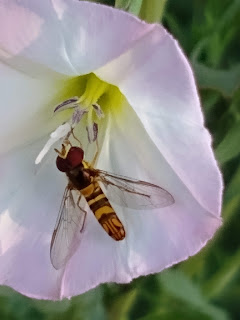This is the time of year when migrations begin and caterpillars hatch. Kids go back to school and the days start the march towards being colder and shorter.
There is likely to be a lot more of these types of June bugs out. The figeater beetles are very loud and metallic and seem to be more in-your-face than the lined June bugs we had so far this year. This one is feeding on the nectar of a pigweed inflorescense ( a bunch of tiny flowers). It has an awesome face with a tiny rhinoceros snout.
Honey bees sleep in a hive. But most bees, like this one, were sleeping out in the flowers in a small group. This one is on a Russian Thistle (tumbleweed). This type of "sturdy" bee is a sunflower pollination specialist.
Caterpillars use all sorts of tricks to prevent being eaten. Some are poisonous, some are venomous. Some can hide well, others display their badness. This tiger moth caterpillar is hiding by looking like a wheat plant, but it also had venomous spines if spotted.This caterpillar is better organized and looks just like a twig. The color is a bit off, but the camoflage even has little joints where a tree should have them.
All insects have six legs (spiders have eight). The caterpillars that have more than six legs actually do not...??? the other appendages are called prolegs and are not actually jointed. Not a big deal, but actually really is...if you are into evolution, and who isn't? But centipedes....we'll get to that one of these days, but for for now...onwards!
This is one of the very common pygmy-blue. For those artistically inclined, notice the row of "hearts" along the edge of the lower wing. This is the smallest butterfly in the US and the caterpillars are found on pigweed, and saltbrush on the sandy side. Somehow, they were introduced into Kuwait and Saudi Arabia.
This is a species of meal moth. These moths are adapted to living with humans, although this one was in a spiders web. Apparently, Chinese make an "insect tea" from these moth to protect from certain cancers. Efficacy is not known...But if it worked I bet it would be!
A tiny Idaea species of moth, there are about 680 species, but I am no expert. Right now there are some moth experts hunting around the edges of Rio Rancho for some unique varieties with blacklights and nets hoping to find the specific plants they lay eggs on. It gets pretty involved.This is an orb weaver spider species, they make the big, classic web designs. They look...well, I would say awesome, but there is likely a range of opinions. The colors and patterns of some orb weavers are crazy beautiful.
A more typical wolf spider that will be scaring the bee-jesus out of the human population soon. They are almost always drab, and some get big. Every one of them completely harmless.
This year's crop of grasshoppers are going to biblical in proportions. I haven't gotten out to Moriarty on NM Eastern plains, but I'm betting those large sod farms will be seeing an uptick in the locust swarms VERY soon. Locusts swarm, grasshoppers do not. This is a molt of a young grasshopper, a discarded exoskelton. The big deal is the small wings forming on the back, they will soon be much bigger.This adult is not a bee, but a hover-fly. These guys do not get enough recognition for their work as aphid eaters. The young grubs are found near aphid colonies and eat many of them.
These apparently random marks in the sand are likely a gopher snake (up to 8 foot long). They are following their prey, which right now are rodents (they eat snakes too). The foraging behavior of a mouse is controlled by vertical surfaces, like the outside of a house wall. That's where the snakes are found now, especially on the sunny side as fall approaches. Be nice to nature if you find one, I'm not even sure why they need to be "relocated".













No comments:
Post a Comment